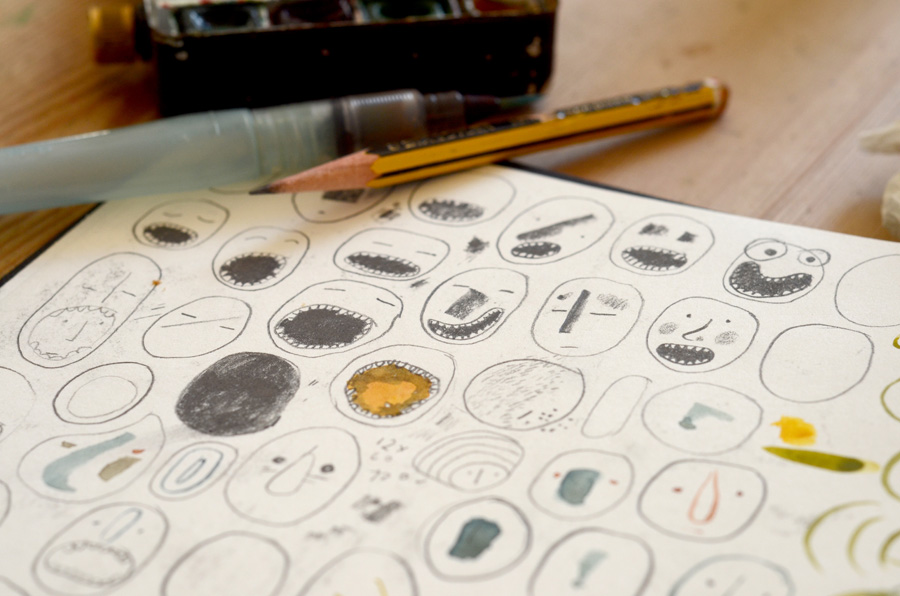As we prepare for Living Lines: An Animated Big Draw we wanted to talk to artists, animators and creators who have devoted their lives to the craft of animation. The thought of creating an animation themed event may seem daunting but we hope that this series of interviews will inspire show just how simple (and fun it can be).
Animation is a enormously diverse art form which is constantly evolving and redefining itself. From the simplest cartoon strips and flip books to the biggest budget CGI features there is something for everybody to explore within animation.
Here is the second part of interview with the wonderful Jim Le Fevre where he talks to us about drawing & visual literacy!

What part does drawing play in your work, and how do you define ‘visual literacy’?
I have a tricky relationship with 'drawing' even though it is obviously at the heart of my work.It is a double edged sword as it is such an important tool throughout the artistic process yet such a devilishly tricky beast to control.
At the most base level I find drawing is the moment a pencil meets a piece of paper and I find that quite exciting, especially when I become frustrated about not being able to 'draw something'. There is a very base level satisfaction to be had in letting yourself go with a pencil or a water-colour brush yet still trying to capture moments while you draw.
The other side of 'drawing', the trickiest side, is exactly the phrase 'Visual Literacy' which is learning what works well together – lines, shapes, colours. This is the thing that people think they refer to when they say 'I can't draw' and puts people off so much which is silly, especially when you look at someone like Saul Steinberg's work.
Visual Literacy is actually something that you can only learn by doing lots of drawing and making lots of marks. While you are doing this you have to look at work by other people that you really like and be aware of how that makes you 'feel'. In doing this you are chipping away at this immoveable block, always looking at what you've done and asking yourself 'Does this work?' and not being satisfied until you begin to feel what you felt from other people's work. It may be a style of mark or a combination of colours and shapes that is the key but when the penny drops you start to change and it becomes more satisfying.
To me Visual Literacy is understanding the balance of what works well together combined with what the piece is for and all applied to the context of where that piece is going to exist, whether that's a small private drawing in a sketchbook or a huge installation in a museum.
I certainly use drawing as a way to express and work out ideas in my sketchbooks but equally I sometimes like to jump straight in to an idea and see what works simply by having a go! It's an age old mantra but the best things I've learnt are through mistakes!

What would your message to the world of 2017 be, regarding visual literacy – just why is it so important?
Sketchbooks!
My message to the world of 2017 is that it is all down to the singular moment of satisfaction that one gets when everything 'works'. It's the same moment of satisfaction you get when you figure out a puzzle and you only get that purest feeling of satisfaction when you do the hard work yourself and that hard work is simply pushing yourself forward and challenging yourself.
'Challenging yourself' sounds really grand but it's sometimes extraordinarily simple and mundane such as that moment when you have a sketchbook open and you are incredibly frustrated that you keep drawing the same thing and you simply force yourself to draw a different circle or a different shape.
A lot of the time it is good to put yourself into a situation where you have no choice but to challenge yourself which is why getting away from the digital world (computers etc…) is so good as you start to beautifully restrict yourself – a sketchbook where there are no undo's - and the challenge is simply to stick with it and start noticing yourself as you draw, how you react to it (angry, frustrated, happy etc…) and how you begin to be able to control those feelings.
Don't treat your sketchbook as a 'picture' you have to get right, treat it as a playground and use every piece of space on the page and before you know it you will be discovering things that no-body could ever teach you!
What is so wonderful when you do this is the almost laughable feeling of liberation.
You can find out more about Jim and his amazing work at https://www.jimlefevre.com/ or follow him on twitter @jimlefevre and on vimeo https://vimeo.com/jimlefevre.
If you have been inspired by Jim's ramblings why not organise and event of your own for The Big Draw Festival 2017. You can register right here.
Our interview with Jim will continue tomorrow when he will be talking to us about his amazing invention the Phonotrope™!
About our blog writer: Oscar Moore
Oscar has been working at The Big Draw since August 2016. He graduated from the University of Bristol in 2015 with a degree in History of Art. He has a particular interest in Modern South American Art especially the Arpillera movement in Chile as well as the work of Oscar Munoz. As a lapsed drawer himself he has loved working towards getting as many people involved with drawing in all its’ forms, as well as rediscovering drawing himself. Outside of the The Big Draw Oscar loves playing basketball (badly) and writing about it (quite well), cooking and traveling whenever time and funds allow!